You are viewing 1 of your 1 free articles
Encouraging combination play
| Area | Up to 60x50 yards |
| Equipment | Ball, bibs, cones, 2 full size goals |
| No. of Players | Up to 16 players + 2 goalkeepers |
| Session Time | Practice 1: 20mins Practice 2: 40mins Practice 3: 20mins Practice 4: 30mins Practice 5: 20mins |
This session is all about finding support positions to encourage combination play and to change the point of attack. In the modern game much is made of the ability to build up play from the back and playing through midfield so angles, distance and movement to receive the ball are all vital elements. The ability to switch play is also vital as a way of beating the block by creating opportunities to deliver the ball into dangerous areas. These practices are designed to encourage all those aspects of play and can be adapted to suit a coach’s specific needs.
I really like this training session because it encourages different methods of play and allows for different formations, different player/team strengths and different opposition weaknesses. It also encourages movement to receive the ball in anticipation of where the next pass is to be played and it schools players in building play whilst retaining possession.
I would run this session regularly because creating a team pattern that allows players to make full use of their abilities is a constant throughout every season. It ensures that players are confident with a system of play that makes full use of their strengths and abilities. However, when preparing to face certain opponents it is also essential to practise a pattern of play based on the weaknesses that have been identified in your opposition to counter their strengths.
“I like this session because it encourages different methods of play and allows for different formations, different team strengths and different opposition weaknesses”
PRACTICE 1
The aim of this activity is to prepare players to receive the ball in response to ball movements and then encourage them to move to support the player on the ball to combine with the outside players.
We set up a playing area of 20x20 yards split evenly into four 10x10-yard boxes. We’re using six players: two are on the inside and four are on the outside – one on each of the four sides. An outside player starts by passing the ball into the receiver (the blue), who is the furthest player inside the playing area. The same blue inside player is always the receiver of passes from the outside and always takes up a position furthest from the outside player with the ball, while the other inside player (the yellow) must always be in the box diagonally opposite the blue receiver (it’s key that the two inside players always support each other diagonally). On receiving the ball, the blue player combines with the yellow to then find a new outside player with a pass. The outside player who receives the ball then passes into the middle again for the blue receiving player, who has a made a run into a different box to receive, as shown [1a].
[1a]
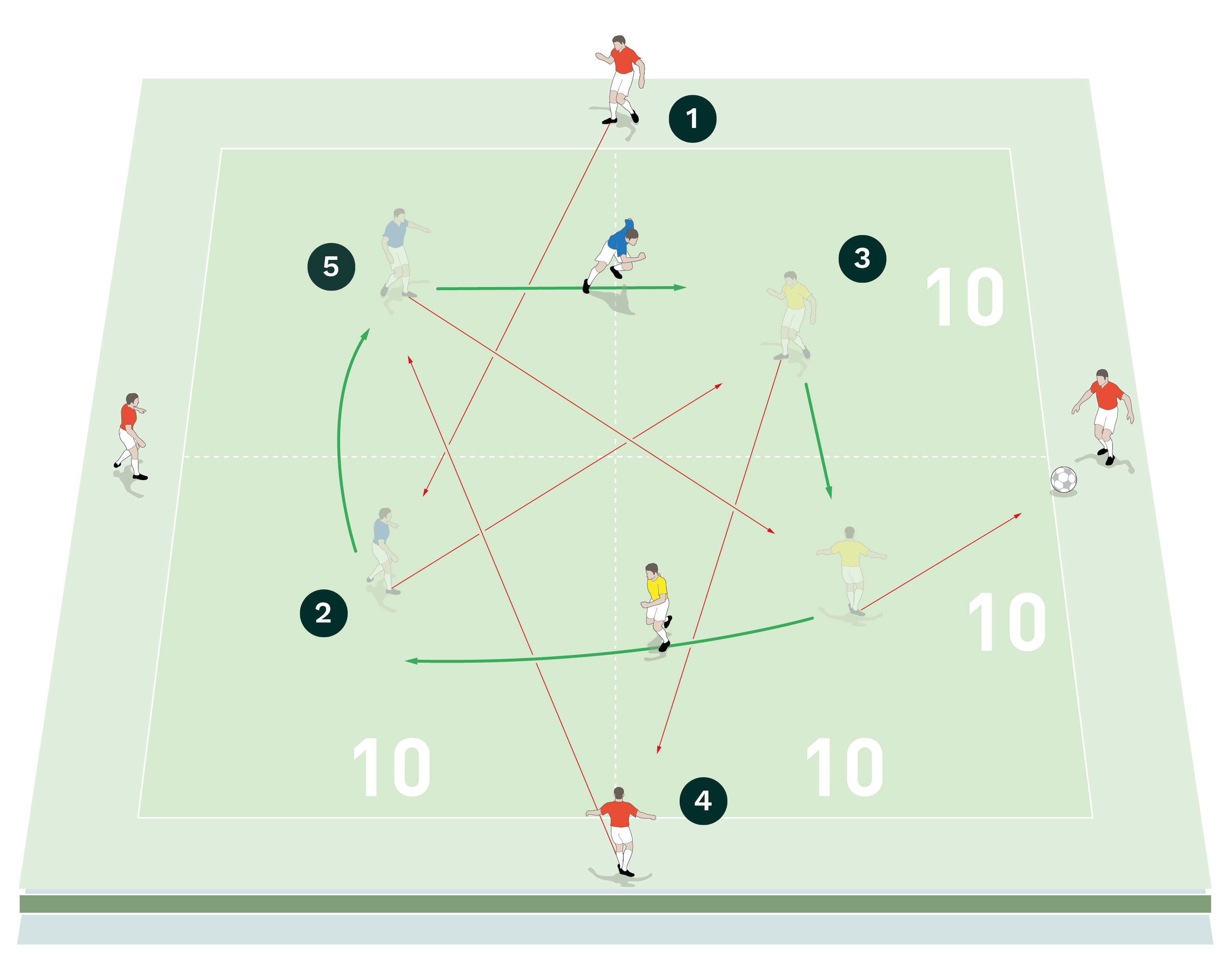
2. The same blue inside player is always the receiver of passes from outside. He must take up a receiving position furthest from the outside player with the ball
3. The blue player receives and must combine with the yellow player to then find a new outside player with a pass. The yellow and the blue must always be in boxes diagonally opposite each other
4. The outside player who receives the ball from the yellow then passes into the middle again
5. The original blue receiving player makes a run into a different box to receive again before combining with the yellow once more
[1b]
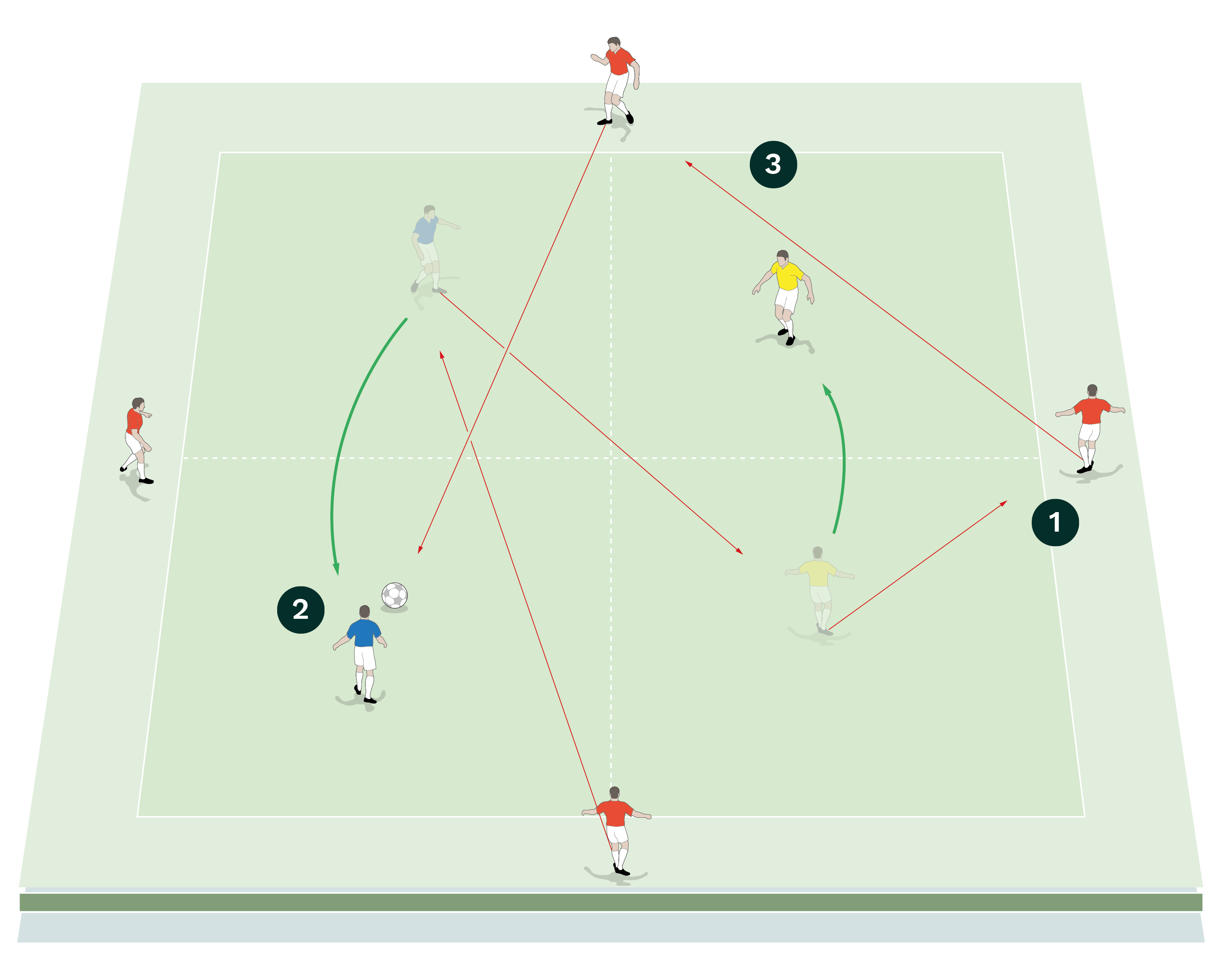
2. Here the blue has moved to the box furthest away from the red passer in order to receive
3. After combining and making a pass to the outside, the yellow player moves boxes to ensure he is diagonally opposite the blue for the next combination pass
“This practice is all about angles and the distance of support in relation to movements of the ball so that quick play is possible”
The ball is played continuously and the activity proceeds in the same manner with a new combination in the middle always followed by a pass to another outside player. The play should always be one-touch where possible.
As a development of the activity, if an outside player receives the pass from the middle and passes to another outside player before the ball is played back into the square, this means that the blue receiver in the middle may have to make another run to receive in relation to the movement of the ball, as shown [1b].
This practice is all about angles and the distance of support in relation to movements of the ball so that quick play is possible.
We play this activity for approximately 20 minutes but we keep changing the central players so everyone gets the opportunity to play in the receiver role and the combination player role.
PRACTICE 2
We set up a 10x10 yard box. We’re starting by using at least five outfield players, four of whom start 10 yards away from the box, with two players at each end. The remaining player starts in the centre of the box. We run a series of combination drills, that need various types of runs and passes to be successful.
The timing of runs and the quality and timing of the pass are very important aspects of this practice. When a defender is finally introduced, the angle of support and timing of support of both the receiver and the passer are both crucial, as is the decision of the receiver whether to turn or lay the ball off. When the 2v2 is introduced in the middle box, an ability to find space or to combine is added to the practice.
Overlapping runs: A player from the top end starts by passing into the centre player inside the box and then makes an overlapping run to support and receive the ball back, before passing to the player at the bottom. The same pattern is then repeated working in the opposite direction, as shown [2a].
Underlapping runs: A player from the top end starts by passing into the centre player inside the box and then makes an underlapping run to support and receive the ball back, before passing to the player at the bottom. The same pattern is then repeated working in the opposite direction, as shown [2b].
Overlapping and Underlapping runs: We’re now using at least nine outfield players, eight of whom start 10 yards away from the box, with four at each end. The remaining player starts in the centre of the box. The running players work in pairs.
[2a]
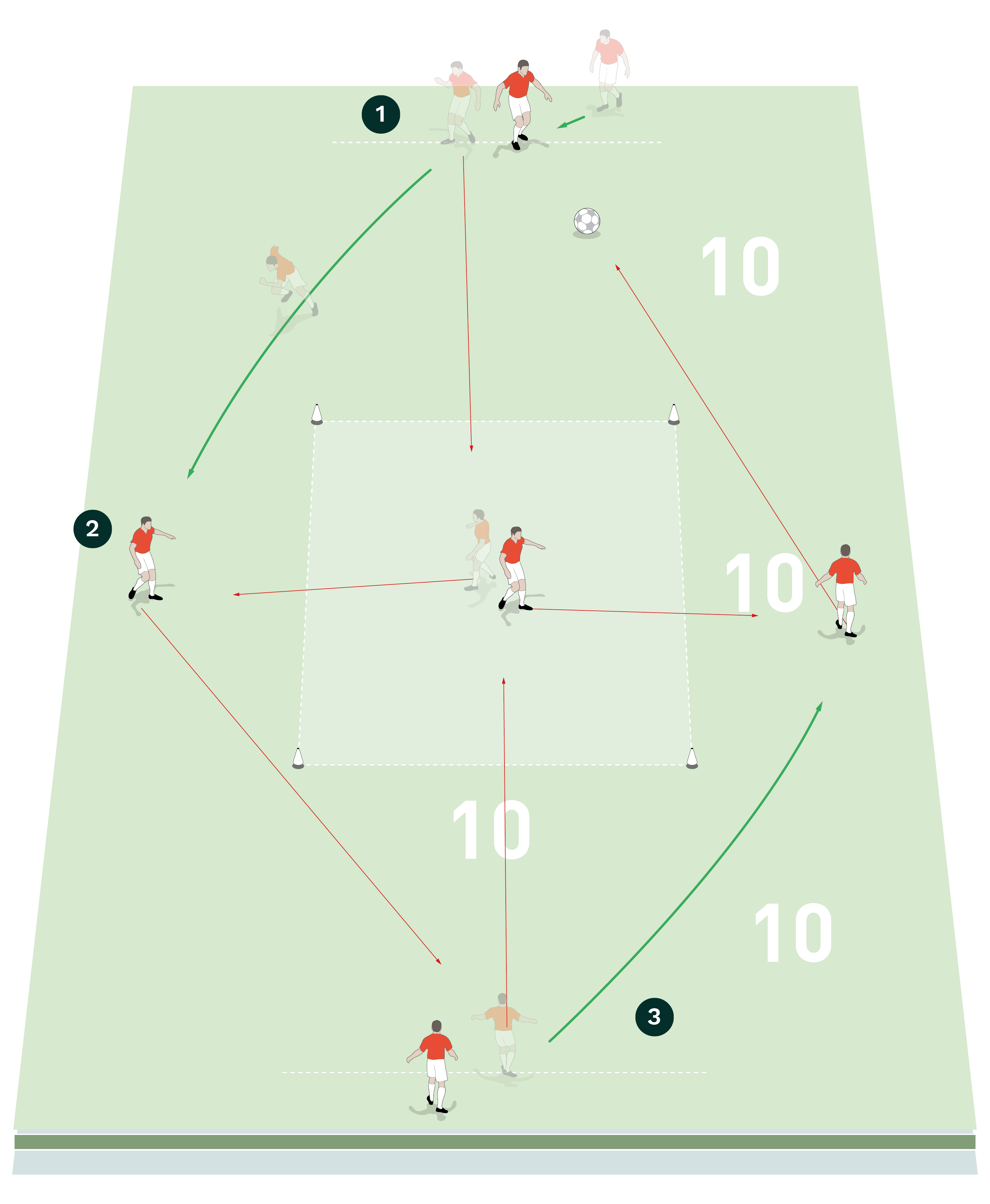
2. The overlapping player receives the ball back from the central player and passes to the player at the bottom
3. The same pattern is then repeated working in the opposite direction
[2b]
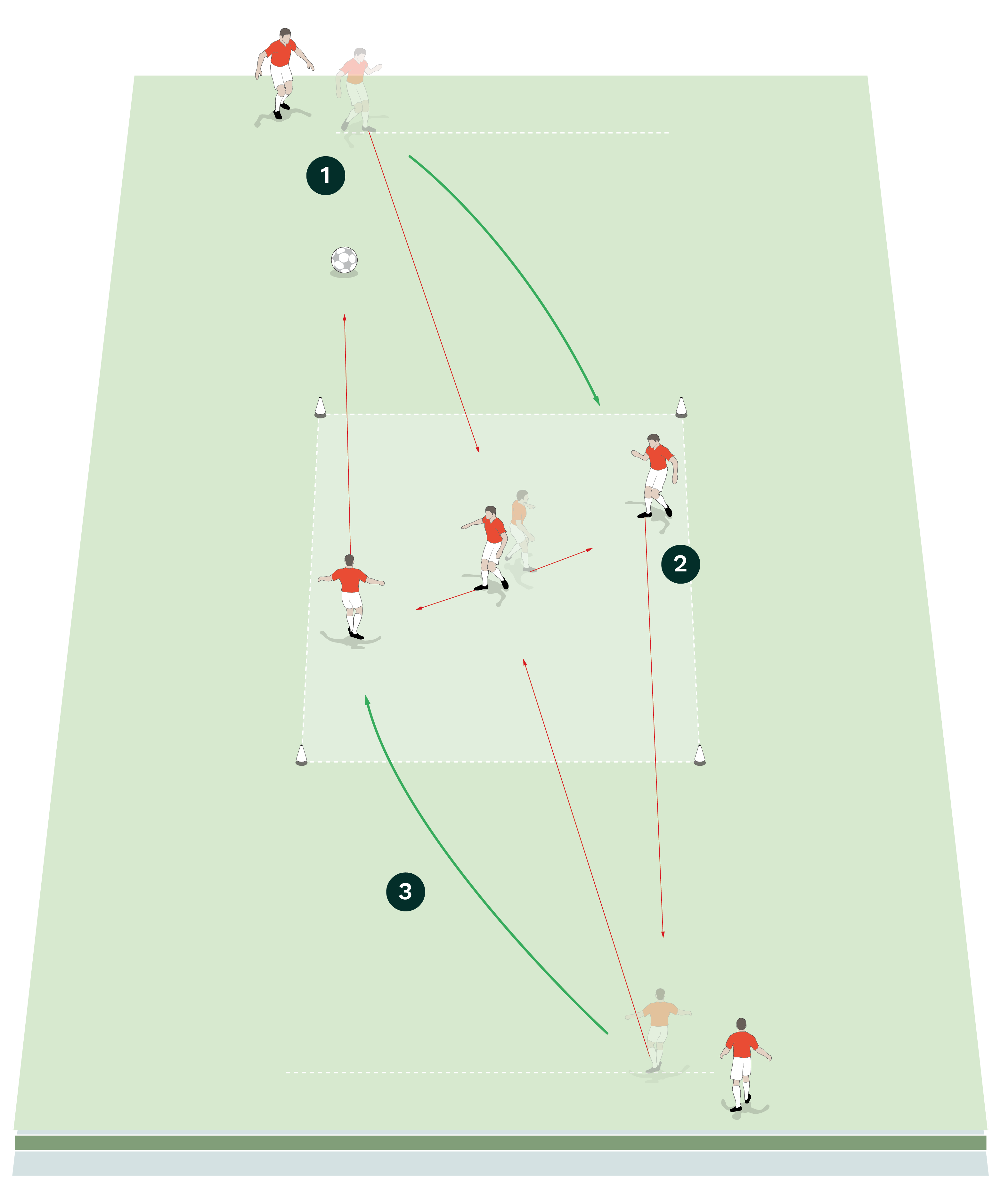
2. The underlapping player receives the ball back from the central player and passes to the player at the bottom
3. The same pattern is then repeated working in the opposite direction
[2c]
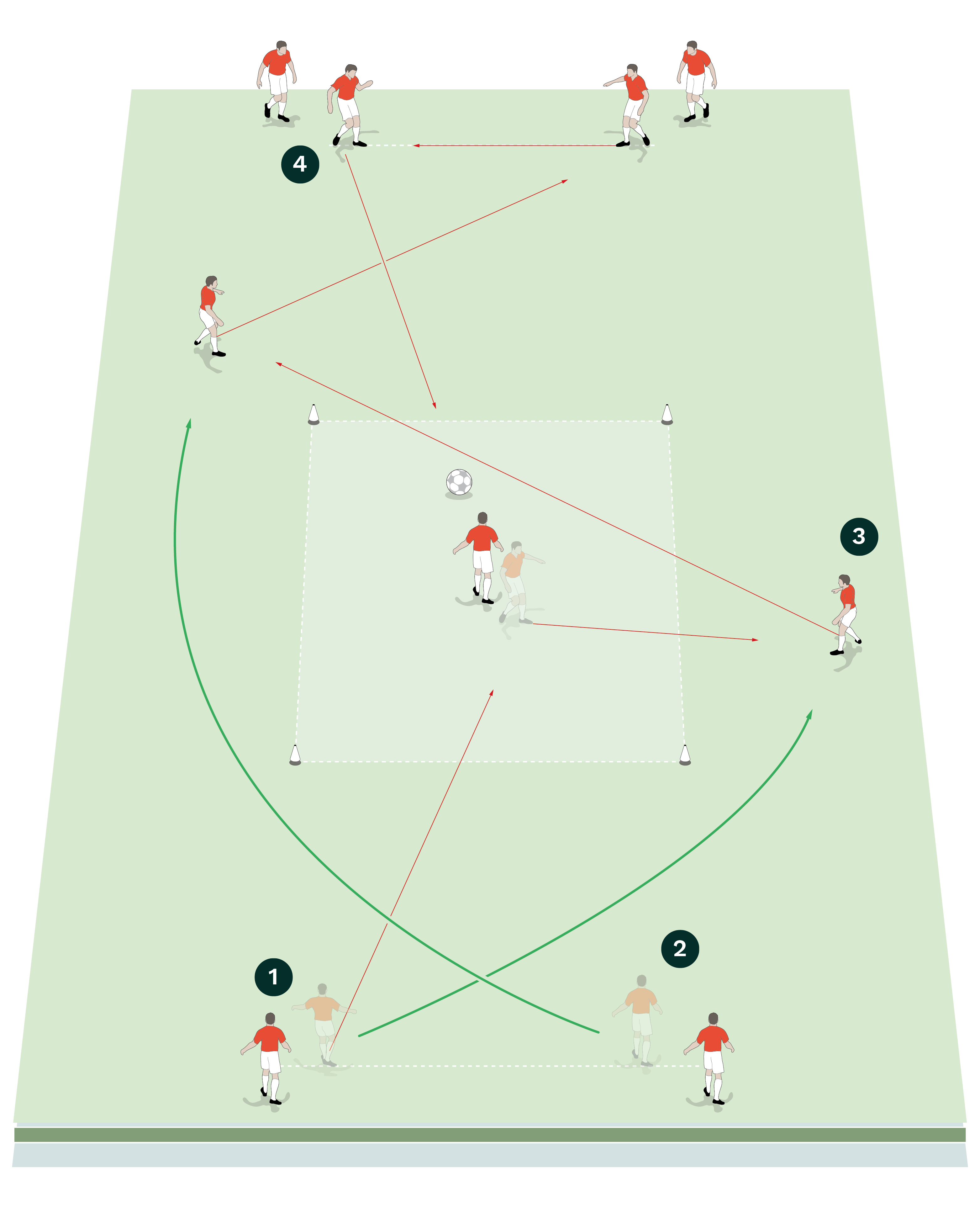
2. The other bottom player from the first pair makes an underlapping run to support
3. The overlapping player receives the ball back from the central attacker before passing across to the player who made the underlapping run
4. The ball is passed into a new pair at the top, who combine with each other before the same pattern is then repeated working in the opposite direction
A player from the bottom passes into the player inside the box and then makes an overlapping run to support and receive the ball back, before passing across to a player who made an underlapping run after the first pass was played. The ball is then passed into a player at the top end before being transferred across to the other player in the top pair. The same pattern is then repeated in the opposite direction, as shown [2c].
Opposed runs 1: We introduce a blue defender in the centre of the box. A player from the top starts by passing into the player inside the box who is now up against the defender. The player who plays the first pass makes an overlapping run to support and can receive the ball back OR alternatively the receiving attacker in the box can turn the defender and play the pass into the path of the overlapping player.
[2d]
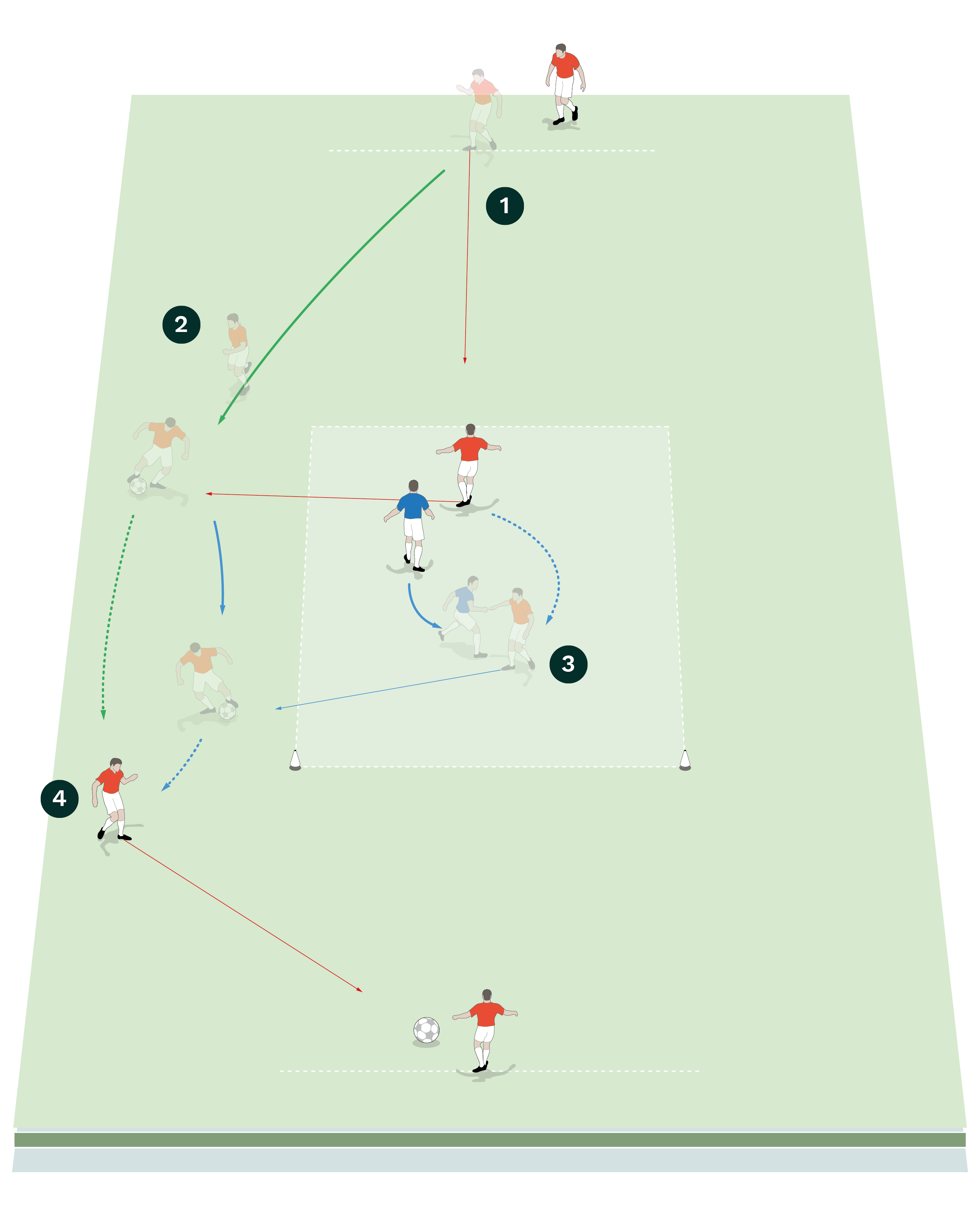
2. The player who plays the first pass makes an overlapping run to support and can receive the ball back from the player in the box with his first touch
3. Alternatively, the receiving attacker in the box can turn the defender and play a pass into the path of the overlapping player
4. Whichever way the overlapping player receives the ball back, it is then passed to the player at the bottom. The same pattern is then repeated in the opposite direction
[2e]
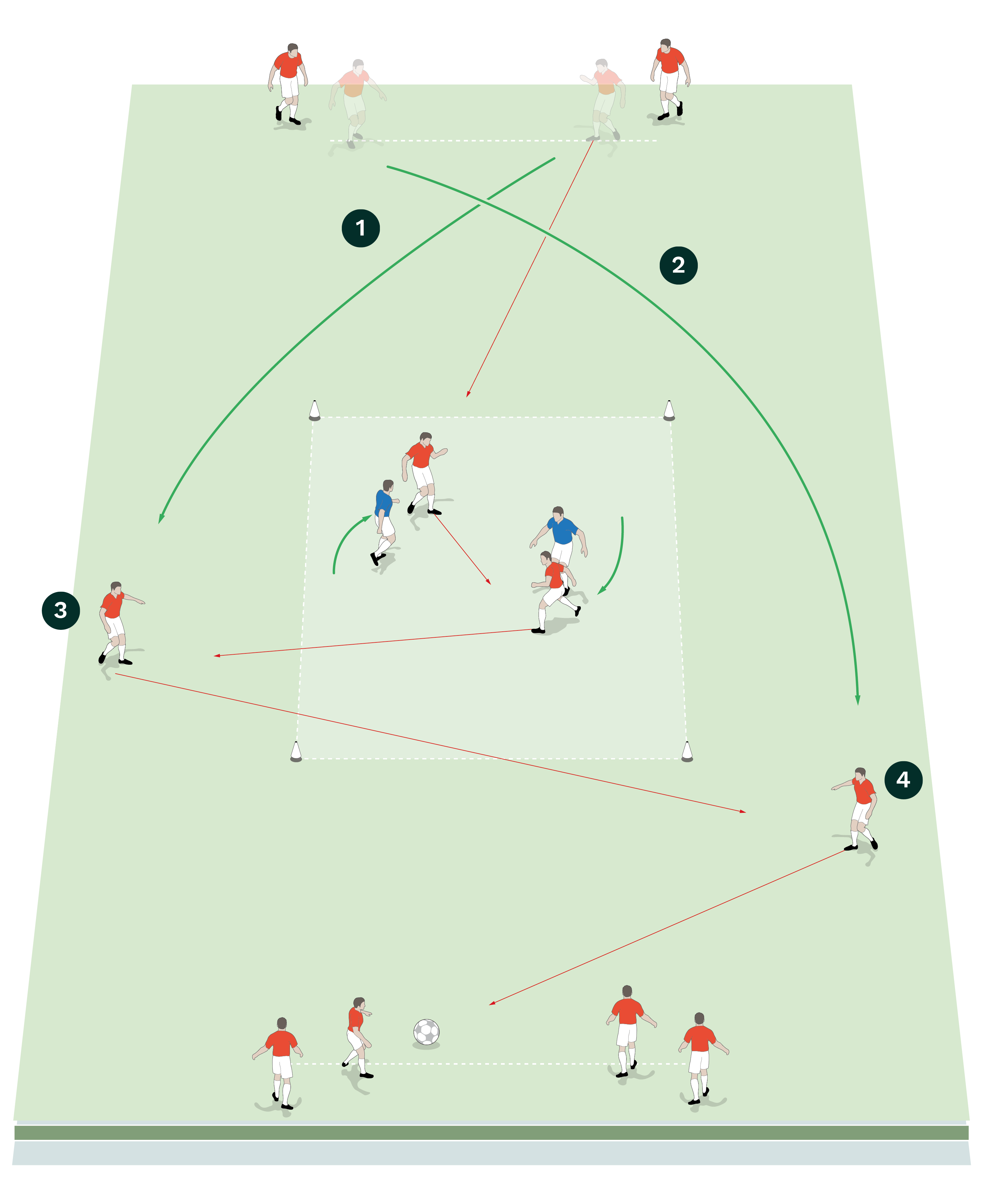
2. A second player makes an underlapping run from the top in support
3. The two central attackers combine in the box under pressure from the blue defenders to find a pass into the path of the player who made the overlapping run
4. The player who made the overlapping run then passes to the player who made an underlapping run before a final pass is played into the new pair at the opposite end
Either way the overlapping player receives on the move and passes down to the player at the bottom. The same pattern is then repeated in the opposite direction, as shown [2d].
Opposed runs 2: We introduce a second defender and a second attacker into the centre of the box. A player from the top starts by passing into one of the attackers inside the box and then makes an overlapping run, while a second player makes an underlapping run from the top. The two central attackers combine under pressure from the defending pair and try to find a pass into the path of the player who made the overlapping run. The player who made the overlapping run then passes across to the player who made an underlapping run before a final pass is played into a new pair at the opposite end. The same pattern is then repeated working in the opposite direction, as shown [2e].
PRACTICE 3
This activity shows players how to use combination play to maintain possession using outnumbered support players whilst encouraging an interchange of positions.
We set up a playing area of 60x50 yards with a 10x10-yard box marked in each corner. We’re using 10 outfield players, split into a red passing team of six and a blue defending team of four. The reds have two players in the centre and one in each corner box. The four blues are in the centre of the main area.
Play starts with a ball passed into the middle from a red player in a corner box. The aim is to find one of the red middle players who should try to combine with the other red middle player if possible, before passing out to a team mate in another corner box. The player who passes out follows the pass to replace the player in the corner box, who now moves into the middle, as shown [3a]. If the red middle players cannot combine, the ball can be played back to any of the four boxes without changing the players in the middle until a combination is achieved.
The ball can also be passed directly from corner box to corner box if needed, although the red corner players should always try to look for opportunities to pass into the red middle players if possible. The two red middle players must try to combine quickly before finding a free corner player.
If one of the four blue defenders wins the ball, they must pass and try to keep possession using their 4v2 overload in the main area, as shown [3b]. We set them a number of passes, say 10, to complete in order to score a point. If they complete their target without a problem, one or two red corner players could be released into the main area to help their team mates retrieve the ball.
[3a]
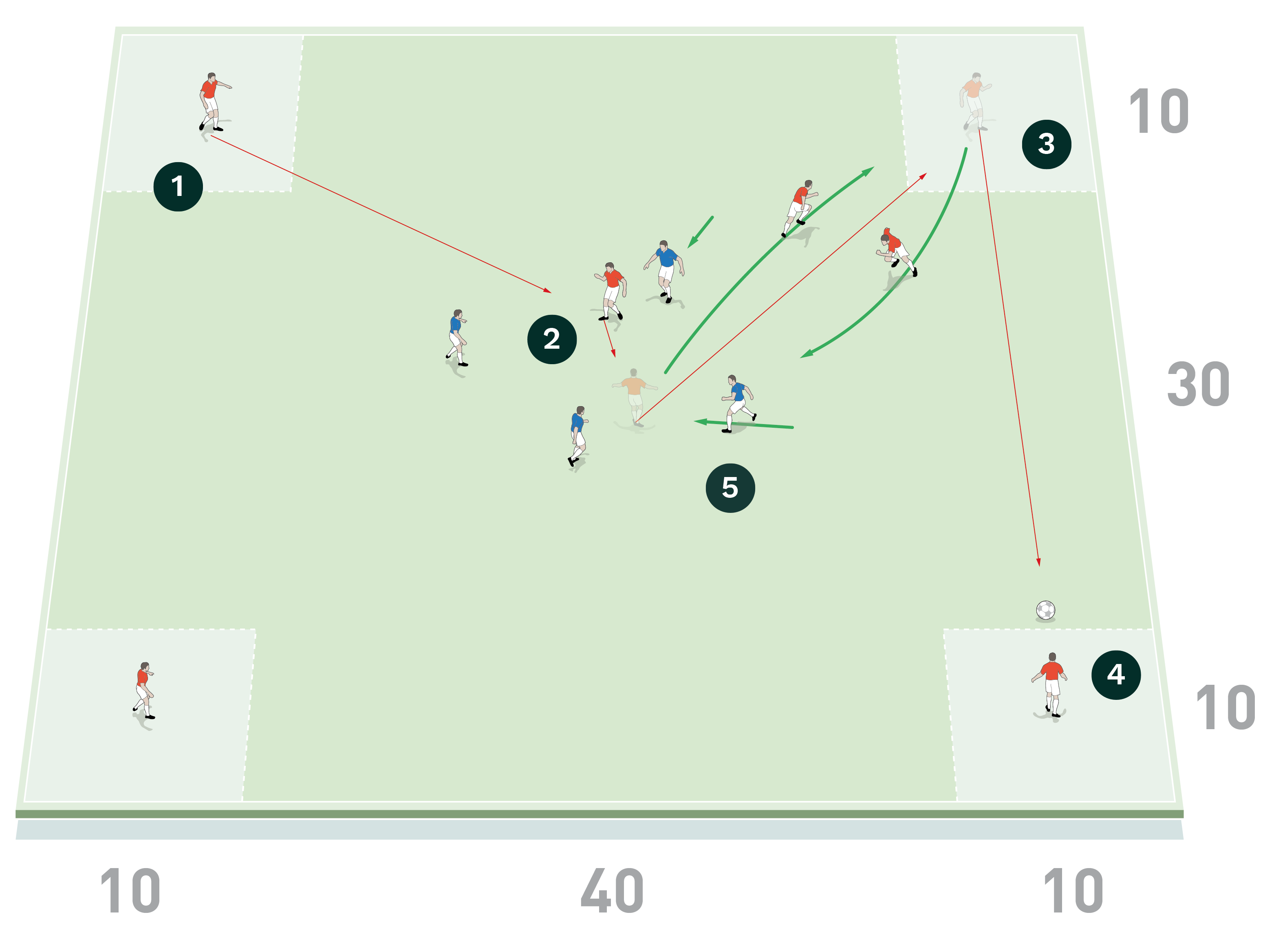
2. The two red middle players should quickly try to combine if possible before passing the ball out to a team mate in one of the corner boxes
3. The player who passes out follows the pass and replaces the player in the corner box, who now moves into the middle
4. The ball can also be passed directly from corner box to corner box if needed, although the red corner players should try to look for a pass into the red middle players if possible
5. The four blue defenders in the main area press and try to gain possession
[3b]
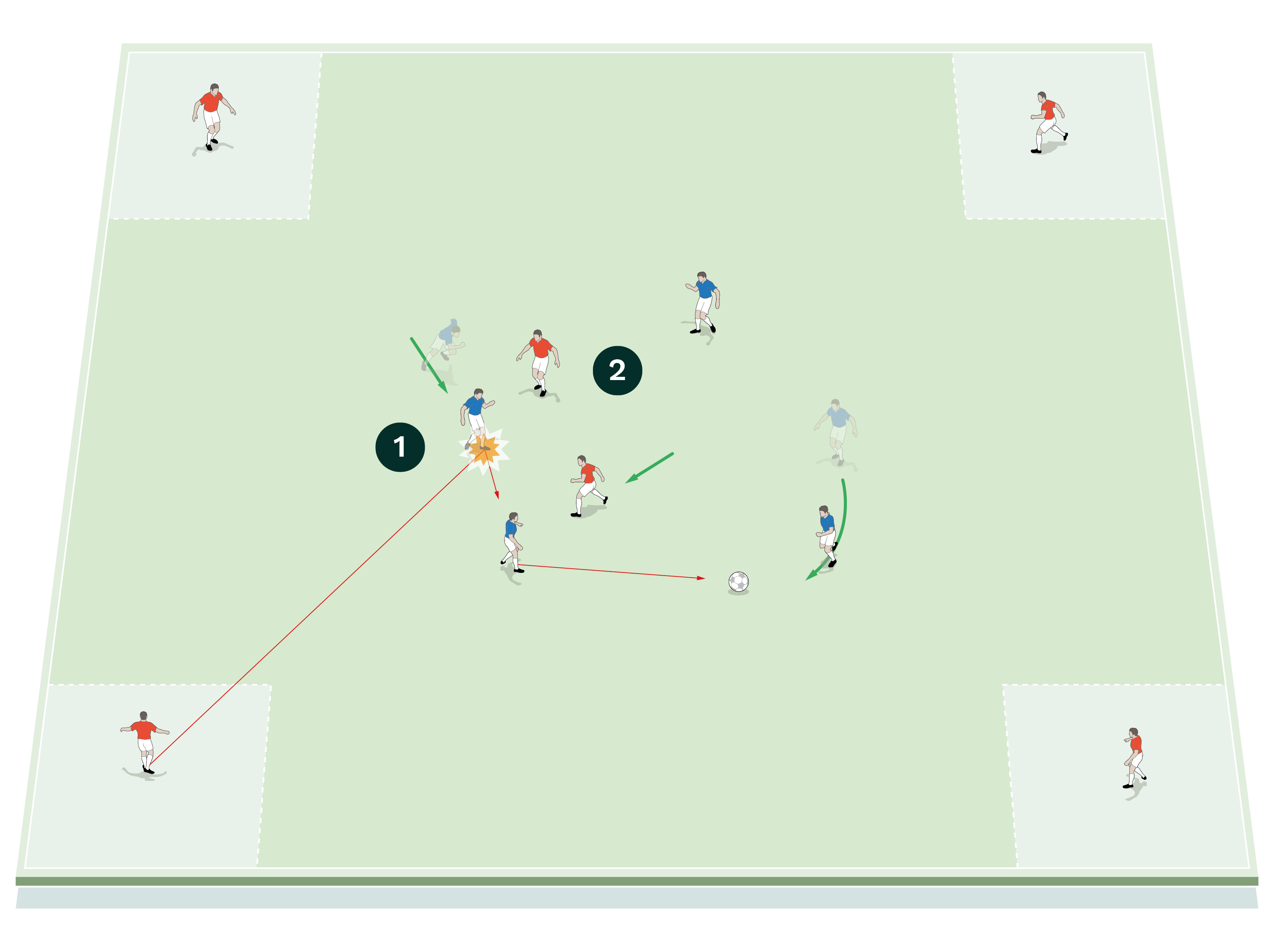
2. The two reds in the middle should counter-press and try to regain possession
PRACTICE 4
This activity is used to encourage players to pass the ball forwards whilst maintaining possession, using width and interchange of positions, plus it shows them how to receive the ball under pressure. It can also be used to encourage counter-attacking if the ball is won by the defending team
We set up a playing area of 50x30 yards including a five-yard goalkeeper zone at each end. We position a full size goal and a goalkeeper at each end. We’re using 10 outfield players, split into a red possession team of six and blue defending team of four. The reds have two players in the main playing area and two supporting players on each side of the pitch, while all four blues are in the main area.
The aim for the red team is to transfer the ball from goalkeeper to goalkeeper to score a point. To do this they can use the four supporting red players on the outside at any time. When the ball is passed into the two middle players, they should quickly combine with each other if possible before moving the ball on, as shown [4a]. Middle players do not have to combine with each other, as a point would still be scored if a middle player made a direct pass to the goalkeeper without combining in the centre.
If necessary, the outside players can play a ball to the goalkeeper but a point would not be scored because points can only be scored if the pass is made by a middle player.
“This activity is used to encourage players to pass the ball forwards whilst maintaining possession, using width and interchange of positions”
[4a]
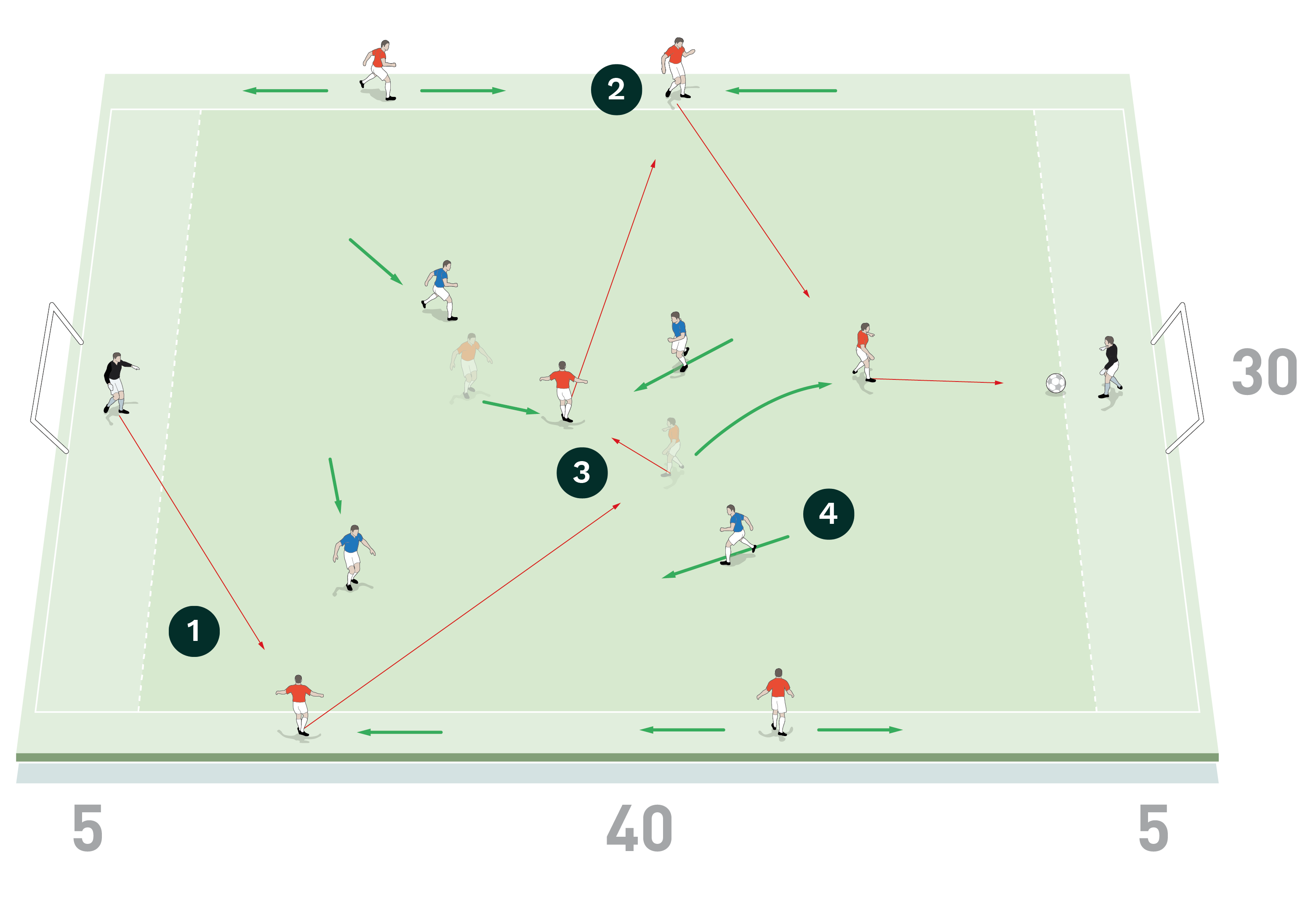
2. Four of the red players support play from the outside, with two on each side of the pitch
3. If the two red middle players receive the ball they should try to quickly combine with each other if possible before moving it on
4. The four blue defenders in the main area should press and try to win the ball
[4b]
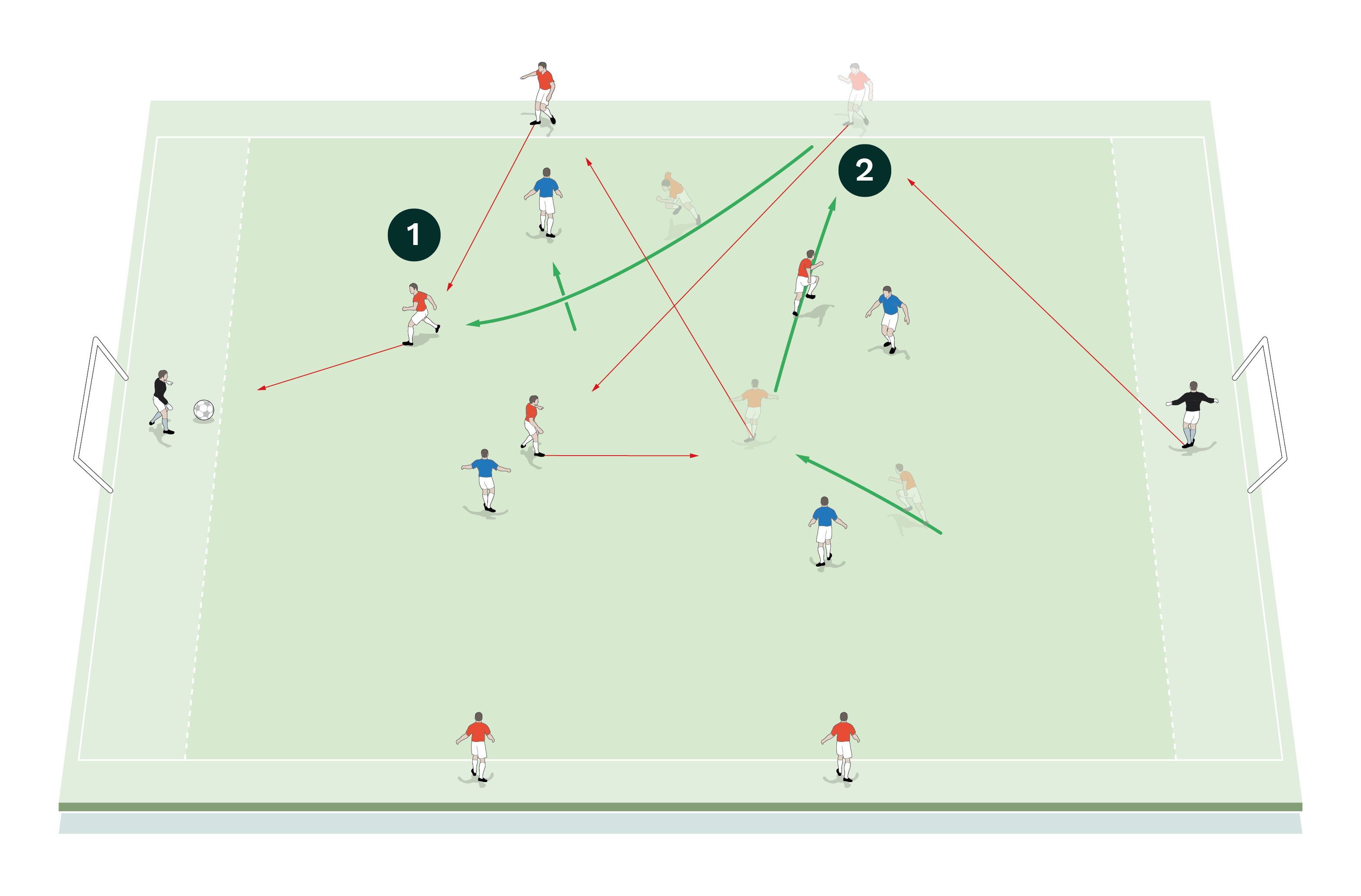
2. When the outside players step into the main area they must immediately be replaced on the outside by a red player from the middle
[4c]
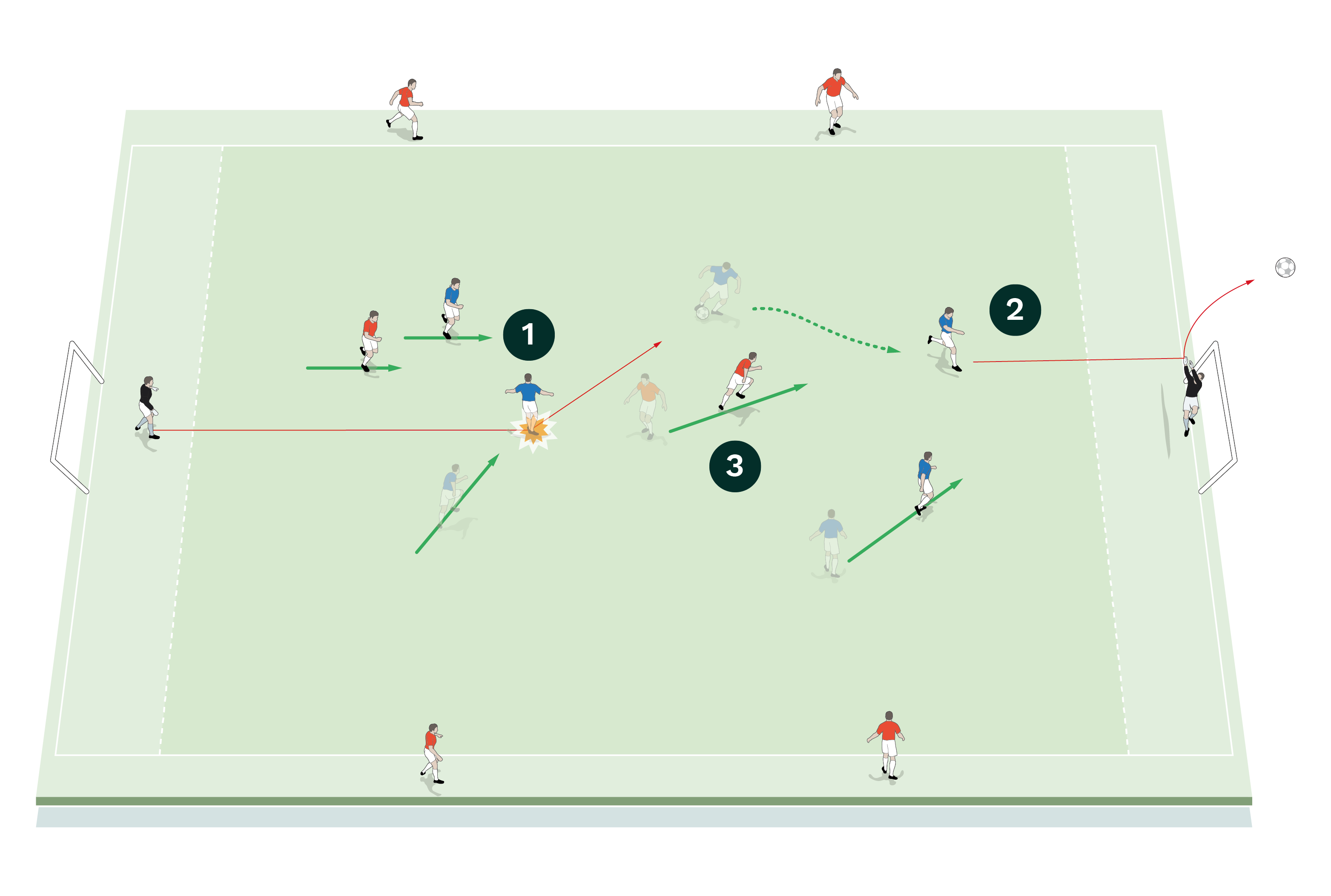
2. The blue players can only shoot from the main area – they are not allowed to score from inside the goalkeeper zone
3. If the two reds in the middle lose possession, they should counter press and try to regain the ball
The red players on the outside of the area can step in and join the play in the main area at any time by making underlapping or overlapping runs to support the play. However, when they step into the main area they must be replaced on the outside by a red player from the middle, as shown [4b].
If one of the four blue defenders manages to intercept a pass or win possession of the ball, they should try to score past a goalkeeper at either end as quickly as possible. However, the blue players can only shoot from the main area – they are not allowed to score from inside the goalkeeper zone, as shown [4c].
PRACTICE 5
This practice is all about switching play to change the point of attack. We set up a playing area of 50x40 yards, including a five-yard goalkeeper zone at each end containing a goal and a goalkeeper. The central zone is 10 yards deep, with 15-yard end zones on either side of it.
We’re using 16 outfield players, split into a red possession team of 10 and blue defending team of four.
Depending on the system of play preferred, coaches can use either three or four red possession players in each of the end zones pressured by one or two blue defenders. It’s 3v3 in the central zone.
Play starts with a pass out from a goalkeeper who has the option to play to any of the reds. The reds must build up play with or without using the goalkeeper again and their aim is to keep possession while working the ball from one end zone to the other and back again. To do this the players are encouraged to switch the play to change the point of the attack.
The point of attack can be changed by switching the ball directly from one end zone to the other, or by using one of the three hard working red midfield players in the central zone, who can lay the ball off for a red team mate in the end zone to switch the play, as shown [5a].
The blue defenders press and if they win the ball, they can combine to score in either goal, as shown [5b].
[5a]
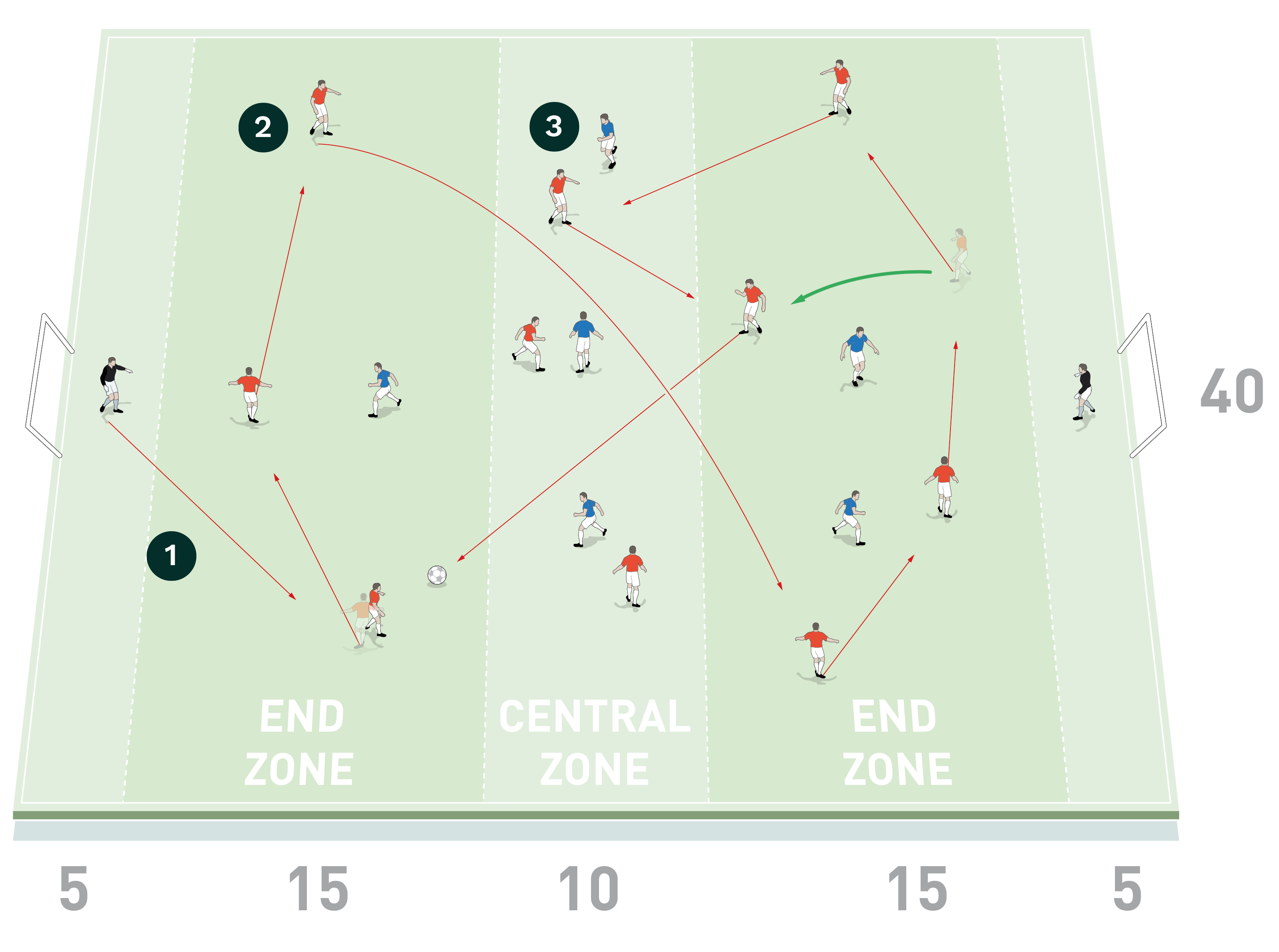
2. The reds are encouraged to change the point of attack. They can do this by switching the ball directly from one end zone to the other, as here
3. The reds can also change the point of attack by using one of the three reds in the central zone, who can lay the ball off for a red team mate in the end zone to switch the play, as shown here
[5b]
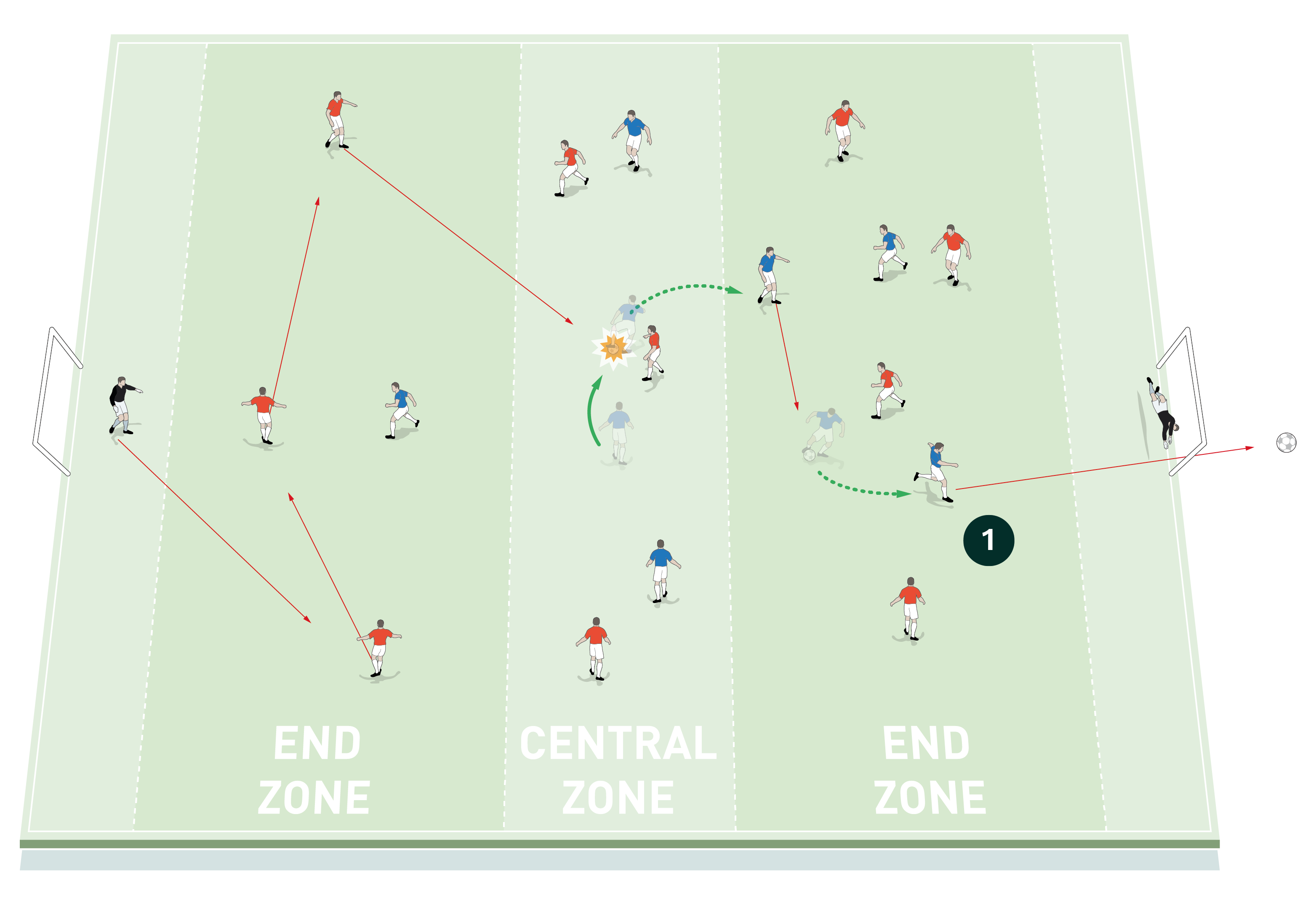
Related Files
Editor's Picks
Deep runs in the final third
Using the goalkeeper in build-up play
Pressing principles
Intensive boxes drill with goals
Penetrating the final third
Creating and finishing
My philosophy
Pressing initiation
Compact team movement
Coaches' Testimonials

Alan Pardew

Arsène Wenger

Brendan Rodgers

Carlos Carvalhal

José Mourinho

Jürgen Klopp

Pep Guardiola

Roy Hodgson

Sir Alex Ferguson

Steven Gerrard
Coaches' Testimonials

Gerald Kearney, Downtown Las Vegas Soccer Club

Paul Butler, Florida, USA

Rick Shields, Springboro, USA

Tony Green, Pierrefonds Titans, Quebec, Canada
Join the world's leading coaches and managers and discover for yourself one of the best kept secrets in coaching. No other training tool on the planet is written or read by the calibre of names you’ll find in Elite Soccer.
In a recent survey 92% of subscribers said Elite Soccer makes them more confident, 89% said it makes them a more effective coach and 91% said it makes them more inspired.
Get Monthly Inspiration
All the latest techniques and approaches
Since 2010 Elite Soccer has given subscribers exclusive insight into the training ground practices of the world’s best coaches. Published in partnership with the League Managers Association we have unparalleled access to the leading lights in the English leagues, as well as a host of international managers.
Elite Soccer exclusively features sessions written by the coaches themselves. There are no observed sessions and no sessions “in the style of”, just first-hand advice delivered direct to you from the coach.









